Delos in primitive times (2500-2000 BC)
The oldest traces of human occupation found at Delos go back to the second half of the third millennium (2500-2000 BC): the inhabited area at Mount Cynthus. It was home to pre-Hellenic populations and a few modest houses, simple shelters for fisherman – or pirates, as Thucydides says (1.8). Between this site at Cynthus and the beginning of the Mycenaean era, there is a gap in the record: practically nothing has been found that can be dated with certainty to the first half of the second millennium (2000-1500 BC). It is the same for all the northern Cyclades.
Delos in Mycenaean times (1400-1200 BC)
The discovery of Mycenaean pottery in different positions in the sanctuary attests to the presence of humans on Delos in the Late Helladic III period (c. 1400-1200). To this level of occupation corresponds the inhabited area in the zone between the Artemision (46), the treasuries (16 and 17) and the temples of Apollo (11-12-13). Tombs have also been found: although even the existence of what is known as the Sema (41) is not completely certain, structure 32, without necessarily being the Theke, is in any case a Mycenaean tombstone. H. Gallet de Santerre has maintained that, from this time onwards, Delos owed its prosperity to these sanctuaries. Today this hypothesis, if not questioned, is at least considered to be impossible to prove. So let it simply be noted that there was at Delos, in the Mycenaean era, a community of humans that may have been fairly substantial, and which obviously had cult sites, but we know nothing for sure about them.
Delos in Protogeometric and Geometric times (10th-8th centuries BC)
Submycenaean pottery has been found at Delos, but in very small quantities. Protogeometric pottery has also been found (in the areas of Treasury 4 and the Artemision, and the Purification Ditch at Rhenea), but it seems to date to the end of the period. Does this mean that there was an interruption in the occupation around the year 1000? This is not certain. In any case, the potsherds are very few in number, and this depopulation and dramatic impoverishment were general phenomena in Greece at this time.
The Geometric era marked an upturn, which became spectacular in the Late Geometric period: at Delos, Late Geometric pottery shows a significant population increase. It is especially abundant to the south of the sanctuary of Apollo. In the second half of the eighth century too, costly bronze offerings appear in appreciable quantities.
The Odyssey mentions Delos (6.162-165): Odysseus compares Nausicaa's slenderness to the palm tree that he saw there. The Homeric Hymn to Apollo (of which the dating varies, according to experts, between 700 and 550) gives us a picture of Delos in the early Archaic period: 'But when your heart, Phoebus, finds the most charm at Delos, it is when the Ionians in trailing tunics assemble in your squares, with their children and their chaste wives… ' (ll. 146-148).The chief divinity is male: it is Apollo. The term 'Ionians' is very precise. Delos was at this time the shared place of worship of all the Ionians joined in a federation (the Panionion), of which the other federal sanctuary was the one at Cape Mycale, in Asia Minor. There is even some reason to suspect the existence of an actual amphictyony, but this, however, cannot be considered as certain.
Delos in Archaic times (7th-6th centuries BC)
A reasonable number of pieces of archaeological evidence suggest the idea that Naxos played a particularly important role at Delos in the second half of the seventh century and the first half of the sixth: most of the statues from this period are – some for certain, others probably – Naxian. The most important constructions of this period are also attributed to the Naxians, the 'Oikos' (perhaps the first temple of Apollo) (6), as well as the Lions (55). No written evidence makes it possible to specify the nature of this Naxian presence. It is probable that it was not of a political character and took no institutional form, and that essentially it was the result of the cultural influence of Naxos – especially in the field of marble working, for statues and building.
-
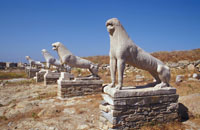
- The Terrace of the Lions (55)
-
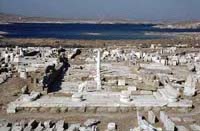
- The Oikos of the Naxians (6)
In the second half of the sixth century, Paros also seems to have taken on importance, without it being possible to speak as a result of 'Parian domination'. Naxos also remained active; it is any case going too far to deduce a political hegemony from an artistic presence.
It was, however, Athens in particular that wanted to affirm its authority over the sanctuary in this period. Following an oracle, Peisistratus, the tyrant of Athens, proceeded to a partial purification and 'purified' the island for the first time, 'not all of it, but what can be seen from the sanctuary' (Thucydides 3.104; cf. Herodotus 1.64): that is to say, he had the graves in this part of Delos removed. This purification dates to Peisistratus' third tyranny, so probably to the period 540-528. It is not at all surprising that Athens, which claimed to be the mother-city of the Ionians, should have sought to impose itself at Delos. This attitude is in accordance with Peisistratus' expansionist policy in the Cyclades: in the third quarter of the sixth century also he helped to install a tyrant, Lygdamis, at Naxos.
This policy seems to have ultimately failed, or rather it ceased with the death of Peisistratus: immediately afterwards, probably c. 525, another tyrant, Polycrates of Samos, affirmed his designs on the hegemony over the Cyclades, and made his mark on Delos.
'Rhenea is so close to Delos that Polycrates, tyrant of Samos, in the period when he had naval supremacy and seized several different islands, including Rhenea, dedicated it to Delian Apollo and linked it to Delos by a chain.' (Thucydides 3.104)
This dedication was a significant moment in the sanctuary's history: it always retained the ownership of Rhenea and the cultivation of the interior of this island provided a large part of its revenues.
Delos in Classical times (5th-4th centuries BC)
Delos reappears in history at the time of the Persian Wars, in 490. The Persian admiral Datis stopped there on his way to Greece; he showed respect to and honoured the sanctuary, wanting to demonstrate to the Greeks that he was not hostile towards their gods (Herodotus 6.97). After the Persian defeat, when Athens created its naval league (478), Delos, as the Ionian sanctuary, was naturally chosen as the headquarters of the confederation. In the temple of Apollo was held the shared treasury, until it was transferred to Athens, probably in 454.
Athenian dominance over Delos was reflected in administrative control of the sanctuary of Apollo. Athenian magistrates, the amphictyons, had the responsibility of administering the god's property. They had the sovereign right to make decisions about the sanctuary's financial policy, although they received assistance from junior magistrates from Delos (neokoroi, episkopoi or epitropoi, and hieropoioi) and Athens (a college of naopoi in charge of building was created in the fourth century) and, for a short time in the fourth century (377/6-374/3), men from Andros who also had the title of 'amphictyons'.
Athens was therefore absolute master of the administration of the sacred property at Delos, but this dominance also took a religious and political form. In 426, the Athenians proceeded to order a full purification of the island and announced that it was forbidden to be born and die on Delos.
'It was fully purified as follows. All the tombs of people who had died on Delos were removed; in future, it was forbidden to die on Delos and to give birth there: for that, it was necessary to be conveyed to Rhenea.' (Thucydides 3.104)
The same year, they recreated the Delia, causing the 'gatherings of the Ionians and the inhabitants of the neighbouring islands' to be revived (Thucydides 3.104.3). By restoring this Archaic tradition, Athens intended to affirm further its hegemony over the Cyclades, to the point of wanting to take over Delos completely: in 422, the Delians were expelled, on account of impurity, but probably also for political reasons of which we are unaware.
'The Athenians drove the Delians from Delos. They believed that, as a result of some past crime, the latter were impure at the time of their consecration; this fact had escaped their notice at the time of the purification which they thought they had carried out by removing the tombs, as I have already reported. Pharnaces gave the Delians the town of Atramyttion in Asia, where they took up residence.' (Thucydides 5.1)
Following Athens' defeat at the hands of Sparta in 404, the Delians recovered control of the sanctuary and, as a consequence, of their territory in its entirety. But from 394 onwards Athens regained a foothold on Delos and again administered the sanctuary. The Delians never wholly accepted this dominance. In 345, they appealed to the council of the Amphictyony at Delphi, but Philip II of Macedon, who then controlled the Amphictyony, was not keen to fall out with Athens, and the Delians were dismissed. Athens probably continued to administer the sanctuary until 315, but we do not possess any administrative act from after 333/2.
Independent Delos (314-167 BC)
The main facts of political history:
During the first decades of the Hellenistic era (323–31 BC), the successors of Alexander the Great fought over the possession of the provinces of his huge empire. In the course of these struggles, after the declaration of Tyre about the Greek cities' autonomy in 315, the Athenians were precluded from the administration of the sanctuary of Apollo, which reverted to the Delians. Modern scholars too have given to this period in Delian history the name of 'Independence'. Delos preserved this independence until 167.
At the time of the liberation of the Aegean islands, between 315 and 313, Antigonus Monophthalmus created the koinon of the Nesiotes, the first federal organisation of the islands themselves, and chose as the common sanctuary that of Delian Apollo.
The fact, however, that Delos played the role of a religious centre in this confederation did not mean that it was subject to the power of the monarchies that one after another controlled the Aegean. The festivals and monuments of the Antigonids on the island are not evidence for the existence of a protectorate any more than the festivals and monuments of the Ptolemies, who were dominant in the Cyclades at the beginning of the third century, or of the Attalids, for example. On the other hand, royal euergetism altered the appearance of the sanctuary with buildings (3, 4, 29, 103) and influenced worship by the institution of new festivals to honour the rulers.
In the second century, Rome's intervention in Greece led the Delians, who were concerned about the coming of a new hegemon, to have the neutrality of their city and the sacred and inviolable nature of their territory recognised anew. Indeed, the right of asylum granted to the sacred port made it a strategic point for the enemy fleets that crossed paths in the Aegean and could put the island's security in danger. As a result the city of Delos carried out intensive diplomatic activities, which were pursued on all fronts without being restricted by political choices, in response to the powers' interest in the sanctuary and to protect its neutrality.
The constitution and administration of independent Delos:
No ancient text systematically describes for us the constitution of Delos or the Sanctuary's institutions, but an examination of their functioning as it is revealed by inscriptions makes it possible to reconstruct various different arrangements with more or less certainty.
Male citizens, who apparently were not more than 1200 in number, were divided into tribes, trittyes and phratries: there were four tribes, each consisting of three trittyes without a territorial basis (unlike the Athenian trittyes), at the head of which was a trittyarch. Tribal rotation was not practised; i.e. political responsibilities were not shared out equally amongst the tribes, probably because of the small size of the citizen body.
On Delos there was, as at Athens, a popular assembly or Ekklesia, of which all citizens were members, and a council or Boule of a more restricted composition. The Ekklesia, which had a meeting space, the Ekklesiasterion (47), had sovereign decision-making power in all fields (external relations, the financial policy of the city and Sanctuary, and public works), and elected magistrates who were not chosen by lot. Appointed by an unknown recruitment method, the Boule, which met in the Bouleuterion (21?), did the preparatory work for the assembly's debates, provided a president for it, and was often responsible for executing its decisions; it controlled the magistrates and played an especially important role regarding finances. Some of the councillors formed a committee that was renewed each month, the 'prytanes'.
Justice was dealt out by at least three courts, the most important being the Heliaia, of which a significant part of the citizens were members.
Several magistrates were appointed each year. The chief ones were the archon, chosen by lot and eponymous (i.e. his name was used to refer to his year of office) and the elected hieropoioi, responsible for the Sanctuary's administration. Notable amongst the other magistrates were the treasurers; three agoranomoi who enforced trade regulations, three astynomoi who were responsible for policing roads and highways, sitonai, officials in charge of buying wheat, a gymnasiarch, assisted by a hypogymnasiarch, and so on.
Choregia was customary: the festivals of Dionysus were the scene of the presentation of a choir of boys and of tragic and comic performances, of which the costs were borne by twelve citizens and four metics.
Exempted from war, as in the third century the poet Callimachus reminds us (Hymn to Delos, ll. 276-277), since it was forbidden to die there, unlike other Greek cities Delos did not have to be concerned about defence. It was also protected from financial worries as it was free to make use of the treasury of Apollo as it wished.
The population, the town, and economic activity:
Obviously exact population figures are not available, but as there seem to have been no more than 1200 male citizens, there cannot have been more than a few thousand freeborn Delians, to which would have been added slaves and, even at an early stage, foreigners, Italians (2), Egyptians (91) and so on. Four to six hundred citizen families, united by a lively spirit of solidarity, constituted a village-like community that was well structured, with the social and political elite made up of property owners, as in all Greek cities at this time.
The town was still tiny, probably limited to the Theatre Quarter (117); the other excavated and non-excavated districts date only from the following era and it has been possible to show that the area that extends to the east of the Sanctuary of Apollo and from the Lake Quarter was still occupied, at least partially, by gardens at the end of the period of Delos' independence. But the town was at that time enriched by a large number of monuments: from this era date the Dodekatheon (51), the Monument of the Bulls (24), the Asklepieion (125), the Aphrodision of Stesileos (88), the main temple of the Dioskourion (123), the Kynthion (105), the Theatre (114), the South Stoa (4),the Stoa of Antigonus (29), the Sarapieia A and B (91 and 96), the Hypostyle Hall (50), the Stoa of Philip (3), the L-shaped stoa of the Agora of the Delians (84), and the Temple D of the Artemision (46). Marked by the ritual ban on dying there, Delos remained without fortifications until the construction of the Wall of Triarius (69) in 69 and never had a cemetery, with the neighbouring island of Rhenea serving as a necropolis.
Evidence for economic activities is provided by the commodity prices given in the accounts of the hieropoioi and the sums collected by the city in taxation. In the third century, the 2% tax obtained on goods bears witness to a modest trade volume, although it partly applies to transit trade. The Cyclades were then able to supply the necessities of basic consumption and in this period Delos was not yet the centre of Aegean trade that it became at the time of the Second Athenian Domination. At most the Delian market played a role as a centre of regional redistribution for the Cyclades and seems to have been organised round the port: the Hypostyle Hall (50), which may have been a market hall where trade transactions took place, was built in this period. As is show by the constant increases in the rents paid for the houses, workshops and shops of which Apollo was the owner, craftsmanship and trade thereafter became more lucrative activities. The accounts of the sacred administration provide information on this subject.
These documents also furnish information about the system of leasing for the farms, 22 in number, that Apollo possessed on Delos, Rhenea and Mykonos. These properties, rented out for ten years, had a more important economic and social role than in other cities: the land rent that they obtained for the god sustained the sacred treasury for more or less half of each year; these estates also made it possible for a whole groups of non-property owning citizens to live from agriculture and livestock farming. These activities were sources of not only social prestige but also substantial revenues: some land rents were more than 1000 drachmas a year, while most sanctuary employees received an annual salary of 120 drachmas. Although they were not able completely to meet the food needs of the population of the island, the agricultural produce from its territory nevertheless must have covered a substantial part of local demand in this period.
Delos during the Second Athenian Domination (167-69 BC)
The events of 167:
At the end of 167, the Roman senate gave Delos to the Athenians: the port was declared tax-free and the Delians soon expelled from their island by the Roman senate. The context of this event was after the war between Rome and the king of Macedonia, Perseus, that resulted in the reduction of Macedonia to the status of a Roman province. The Delians had remained on good terms with the two adversaries. It seems that the senate did not so much want to punish the Delians for their benign neutrality towards Macedonia as ruin a powerful enemy, Rhodes, economically; indeed, the immunity from taxation of the port of Delos contributed to the decline of Rhodian trade.
The population: growth and cosmopolitanism:
Immediately Athenian colonists settled on Delos – poor and, more likely, well-to-do people who established themselves there as civil servants and traders – but their role declined progressively between 167 and 69. The two main demographic facts concern different issues:
- population growth: the excavations continue to bring to light a town of which the extent and appearance we are beginning to grasp properly. The chronological criteria that we have almost always lead us to date the Delian houses to the second half of the second and the beginning of the first century. It must believed that in the course of less than a century (second half of the second – beginning of the first century) the development of the town of Delos mushroomed for reasons strictly connected to trade. It is difficult to estimate this population as we do not have any baseline data.
-
cosmopolitanism: this sizeable population came from different regions of the Mediterranean world: as well as the Athenians, Greeks from other cities, very many Italians (2), Egyptians, Syrians (98, 118), Phoenicians (57), people from Palestine (99), Jews and Samaritans (80) took up residence at Delos for reasons linked to trade. They were responsible for the flourishing of eastern cults on the island in this period. The Establishment of the Poseidoniasts of Berytos (57) shows that some ethnic groups had their own premises.
-
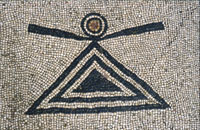
-
Mosaic of the symbol of the Phoenician goddess Tanit.
Found in the House of the Dolphins (111)
-
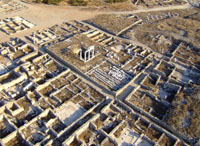
- The Establishment of the Poseidoniasts of Berytos (57)
The Athenian administration:
At the head of the administrative structure was the epimeletes, an annual magistrate appointed from amongst high-profile families and, it seems, after he had held other responsibilities. The details of his functions are not well known, but they were considerable and covered all civic, religious and trading matters.
Other magistrates were more specialised: administrators of the sacred property, magistrates in charge of monitoring warehouses (epimeletes of the emporion, agoranomoi), gymnasiarch in charge of the gymnastic establishments, gymnasium and palaestras (76, 66, 67).
-
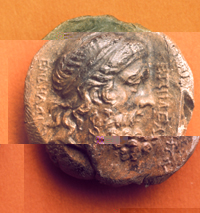
- Imprint of the seal of the epimeletes. Found in the House of the Seals (59 D)
- Inscription: ΕΠΙΜΕΛΗΤΟΥ ΕΝ ΔΗΛΩΙ
The catastrophes of 88 and 69:
Apart from a slave revolt at the end of the second century BC, of which we barely know more than the existence, few events marked the history of the island from 167 to 88. The latter year saw a war between Rome and Mithridates Eupator, king of Pontus. Athens took the side of Mithridates, but Delos adopted an attitude of political independence, under the influence of the numerous Italians on the island. In the autumn of 88, Mithridates' troops seized Delos: according to Appian and Pausanias, who probably exaggerate significantly, the island was completely ransacked. Then Sulla, victorious, visited Delos, of which Athens again received the administration; the traces of the catastrophe of 88 were erased.
A second catastrophe arose in 69: the pirates of Athenodorus, allies of Mithridates, landed on Delos and ransacked it. The wall that the Roman legate Triarius had hastily built to protect it has been found (69). Nevertheless, it would be wrong to believe that the sack of 69 led to the complete abandonment of Delos. The town was gradually deserted for reasons that were the opposite of those that a century earlier had made it suddenly grow: because of competition from Italian ports such as Puteoli and the establishment of direct trading relations between the east and Italy, Delos ceased to be a stopping-point in Mediterranean traffic.
Economic activity:
Delos of the second and the beginning of the first century was above all a trading centre, which is the key fact that explains the 'Delos scenario': the swift development and abandonment of a mushrooming town, and the cosmopolitanism of its population. The focus was above all on transit trade, which probably concerned goods of all sorts. A passage of Strabo (14.5.2) has made the slave market at Delos famous, but this does not mean that slaves were the only or even the main traffic. A consequence of the trading activity was the development of banks; there was a public bank with which private banks run by Italians and easterners energetically competed (so Philostratus of Ascalon: 99).
For information about the agricultural production in this period, we do not have accounts analogous to those of the Independent era, but archaeological exploration of the territory makes it possible to state that cultivation certainly continued, although the products of local agriculture were no longer anything more than a secondary supply.
As for craftsmanship, in addition to the flour mills and oil producers (121.2) that supplied basic food products to a population that had become more numerous, the scraps from manufacturing found in the houses and shops around the Sanctuary testify to the existence of many different types of craftwork and luxury products, intended for a well-to-do clientele, both residents and those passing through: sculptors' workshops (52 and 83), coroplasters, toreutes, glass-makers, makers of purple dye (79.1 and 80.1), perfumeries (79), and auloi-makers (54 and 82).
The economic prosperity of Delos, at least until 88 or so, can clearly be judged from the living spaces of this time: the architecture and painted and mosaic decoration of many houses are expensive. There are also other marks of wealth: unlike what was customary in the rest of ancient times, 5% of lamps from Delos then had more than one spout – from two to thirty – which proportionately multiplied oil usage and were evidence for lighting of an unusually luxurious degree.
-

- Mosaic depicting Lycurgus and Ambrosia. Found in the Insula of the Jewellery (59 A)
Delos during the imperial era
Delos then became again a small town, but was, however, occupied without interruption until at least the sixth century AD. Its extent was reduced: its limits were the coastline to the west, the Establishment of the Poseidoniasts to the north (57), the Eastern Road to the east, and the bottom of the Theatre Quarter to the South. In this area some ruins from the imperial era can still be seen (35, 50, 84). The installation of wine presses at several locations in the ruined Hellenistic town (121.1) testify to the town's ruralisation in this period.
In fact, it was no longer anything but a sparsely populated village, and if the authors of the time enjoyed waxing lyrical on the theme of Delian desolation (Dilos – 'the visible', by a false etymology – became adilos, 'invisible'), this was probably with reference to the huge Hellenistic town, of which the abandoned districts made the contrast between past and present striking, because in reality the town of the third century had not been much more extensive. The administration of the time seems to have been concerned with preventing the unauthorised use of the deserted residential districts, because it was almost certainly responsible for the walling up of some external doors (this can still be seen in the Theatre Quarter).
Not much is known of the island's history: the reign of Hadrian (117-138), an emperor of philhellenic tastes, saw a revival in religious life (each year the Athenians sent to Delos a dodecad, i.e. an offering of twelve victims) that did not last. Indeed, some time later the Athenians even came close to selling the island.
Delos after the end of the pagan era
Around the end of the third century AD, a small Christian community appeared at Delos. Owing to its ancient prestige, the island even became the seat of a diocese that grouped Keos, Kythnos, Mykonos, Syros and Seriphos. Excavations have yielded the remains of several churches (the only surviving one is the Basilica of St Cyriac, 86), a monastery, and various different objects and inscriptions.
The relative prosperity of Delos declined rapidly from the beginning of the sixth century onwards. Hierocles' Synecdemus (inventory of dioceses), produced around the middle of the sixth century, takes up the Dilos/adilos wordplay again, although the island is still present in the list of towns belonging to the province of Greece. In the eighth century, Delos no longer even features in the list of islands attached to the new diocese of Syros.
Devastated in 727 by the iconoclastic emperor Leon the Isaurian, in 769 by the Slavs, in 821 by the Saracens who had come from Crete (a graffito, otherwise not securely dated, from the Stoa of Philip, 3, bears witness to the Arabs passing through), Delos, ruined and deserted, was conquered by the Latins after the capture of Constantinople in 1204. In 1326 a detachment of the Knights Hospitaller of St John came to establish themselves there with a fleet at the instigation of the dukes of Naxos, to fight piracy. It is more probably that they stayed on Rhenea than on Delos. At the beginning of the fifteenth century, they left the island. Conquered by the Turks in 1566, Delos, known as Sdili, was now merely a refuge for pirates and an inexhaustible quarry for the inhabitants of the other islands. It remained under Turkish control until the Greek War of Independence (1821-27).
© EfA / Guide de Délos 4th ed.
